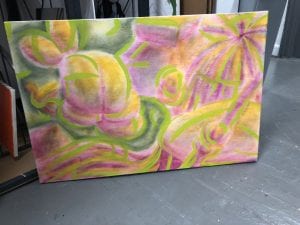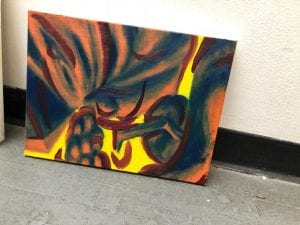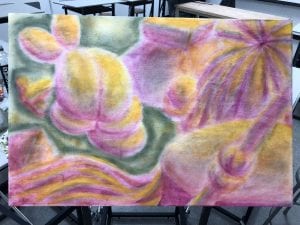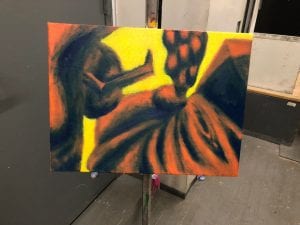My questions for my interviewees are to inform my understanding of how certain people value objects and commodities, specifically people who are involved in the practice or study the selling and or presenting them. It is fairly simple to interact and consume an object or form and build your own thoughts about it, but it is different to understand the intentions of the person who allowed or attracted you to do so. Each interview has questions tailored for that specific person.
Interview 1:
John Phan
Graphic Designer
John: I’m John Phan and I consent the use of this interview.
Vincent: Hi John, I am interviewing you because as a designer one of your key jobs is to communicate ideas and experiences about certain products, brands, or companies in order to attract your audience to interact or purchase something. How has your value and view, if it all, changed towards the products and objects around you since you started designing/advertising?
J: When I am buying stuff I sort of see objects for what they are now. I don’t get wrapped up in packaging, design, or resell value. I’m more concerned with how it’s made and if it’s efficient. Of course visuals matter though, if the world around us was always drab and worn down it would affect our mood. Good-looking surroundings boost your mood and outlook toward your surroundings. The thing is good design and visuals does not equal to perceived brand value. There are good products that get overlooked because the brand is not high end. Perfume for example is dirt cheap to make, but designer companies sell it for hundreds of dollars per bottle.
V: Since you have come to see commodities more objectively has that informed the way that you approach the way you design to sell a product?
J: I’ve become more grounded in the way I approach it. I’m always trying to genuinely depict what or who I’m designing for as much as I can. I try to make genuine experiences and interaction and instead of recycling and rotting visual trends. Design has to make sense, be innovative, push forward, it can’t just be meaningless pretty visuals.
V: What do you think of the objects that are sold at extremely high prices simply because of a brand or artist affiliation?
J: I think something is only as valuable as someone thinks it is. Someone can preach objectivity and the reject façade that brands put on to sell their products so high, but at the end of the day if someone is willing to pay a certain price that is what it’s is in reality.
V: This is Damien Hirst’s commissioned Camel cigarette pack. He said the choice of butterflies is because they have the shortest life span. These are of course are being resold at higher prices for over 500 dollars. Give me your thoughts.
J: He’s a genius. He took Camel’s money, made his statement and left. He didn’t play by Camel’s rules, he was genuine in his design choices. If that’s what they’re worth that’s what they’re worth. In twenty years MOMA will probably buy one. This guy is Warhol to the 10th power.
V: Thank you for time John your perspective is insightful.
Interview 2:
Alexander Riker
Economist
Alexander: My name is Alexander Harland Riker and I authorize the use of this interview for academic purposes.
Vincent: All right Alex, one of reasons I chose to interview because I know you’re an economist and you are, from the people that I know, the least of an avid consumer. You’re not attached to fashion commodities and are resourceful in the way you reuse, modify, and repurpose the things you own. So, can you expand on how you have come to value the objects you do? And has that informed why or the way you approach economics?
A: There’s two aspects of that. One is the fact that my mom often always used to throw away my stuff for no reason and I would go out one day and I would come back… So that has always to taught me to make everything my own and keep it dearly. Try to keep it as much as I can and try to really maximize the utilization of each commodity and the durability that they’re made to last for. And the other part has to more do with growing up in a family where sometimes we’d struggle to reach the end of the month, that teaches you a lot. Teaches you the priorities of how to spend your money. And so I’ve never seen it necessary for my happiness or social standing for me to have the best brands. For example, I’m from Italy all my friends used to have a moped— even before the moped a bicycle my friends all had a bike when they were seven, I got my first back at thirteen. And after one year of having a bicycle all my friends had a moped because that’s when you get your license. I’ve always been unable to reach the trends that my friends could, it’s just a consequence not being spoiled.
V: I can understand that. You’re attached themselves, the ones you have, just not to the idea of consuming more objects.
A: Yes that’s true that’s what I live by. I feel one of the greatest virtues that a human being can be judged by is their ability to show restraint when it comes to spending money. A prudent man a frugal man is man that can truly maximize his happiness because happiness isn’t derived from commodities that are absolutely useless to you that are just to show the emblem of what society stands for… a man that is prudent or frugal will always be happy because he’ll always have sufficiency and the ability to just get what he needs and nothing more nothing less.
V: Did the way you have come to value objects through the way you were brought up inform your choices to pursue economics, politics, and history?
A: It definitely did as everything does, If I had been more demanding about my parents money I probably wouldn’t have the means to even be here here in New York to survive. And even worse to go to school, which is the reason I’m here. Always waste is a huge problem I mean I’m twenty two I’ve inherited a world which is absolutely filled with things that are older than us. If everybody just paid a little more attention to avoid the trains the gain and end quickly, the tiny bit of satisfaction you get from buying into trends, and pay more attention on how to actually make a better future for our children.
V: Since you’ve become interested in economics how has your views towards commodities shifted and the way the world around you works?
A: A lot definitely, economics is a behavior more, commodities don’t have to be a negative it’s a natural consequence of social development, the barter of it, it’s normal. What is not normal is that a commodity that has little to no value in the world today can be sold at prices unimaginably higher than what it is made to produce. You see it a lot in brands like Supreme and brands that have hype that just try to keep the market scarce so that those commodities, a logo can create wealth. Which is stupid because that money could be spent in a more effective way.
V: Although it’s impossible to do so completely, at what point did you start removing these logos and visual systems from your value system?
A: What I’ve started to do is not care as much is how pristine an object may be. I tend to buy bigger brands clothes from outlets or seconds hand shops. I think you told me previously the production of jeans is damaging to the environment just the amount of water alone is insane. The production of denim in the last fifty years has been so high that there’s a enough denim in the world, in trash bags, in second hand shops that there’s no need to produce more just to recycle.
V: Alex this here is a Camel Pack designed by Damien Hirst. Camel commissioned him to do a pack and he did one with these butterflies and said the reason he chose them is because they have the shortest lifespan. These are being resold upwards of $500 dollars. What are your thoughts?
A: It’s interesting because he took a corporation’s money and designed a cigarette pack that is a rejection of capitalism and specifically cigarettes, but at the same time promoted the cigarettes. And the fact that they are being resold at an absurd price definitely adds to it.
V: Well Alex thank you for your time this was very informative.
Interview 3:
Gilbert _____
Business Owner/CCO
Gilbert: I’m Gilbert and Vincent has permission to use this interview without disclosing my last name.
Vincent: Thank you for squeezing me into your busy schedule for this interview. The reason I chose to interview you is because I am interested in how someone as yourself, a self made businessman who comes from poverty, has come to view the objects around you since you have owned business and began to sell your own commodities.
G: Well having my own businesses and building my own brands means I can relate and gauge the work that other companies and brands put in to get where they are. When I see other companies making moves and even the companies that stay at the top of their industry and then I see their products in person I can appreciate all the works that went in to getting it to my hands at that moment. I will buy a Louis Vuitton bag at that price not only because I can afford it, but also because I respect the brands presence and longevity. I don’t know anything about French fashion or fashion in general, but it has come to signify something different to people.
V: Do you think your own products are equal in value and price?
G: I think I put genuine work and attention into my businesses, I think my products speak for themselves in quality and innovation within their respective industries. I have built my businesses from scratch and hold majority shares in them all. So I think that our prices are fair for being a high-end leader in the industry.
V: This a Camel cigarette pack designed by the artist Damien Hirst. When asked about his choice to use the butterfly motif he said it was because they have the shortest lifespan. Some only live 12 hours from when they are born. These are being resold at high prices over 500 dollars. What is your response to this?
G: I’m not much into art, but he got paid and made a statement on the health impact. People will pay for what they like. I think it’s good promotion for the artist and Camel too even though he belittled them. Resell prices are a good way to gauge the public value and buzz around a brand. People will pay a high price for something they highly value, but not if they feel like they’re getting ripped off. Camel wouldn’t be able to sell many packs if they directly priced them at $500.
V: Thank you Gilbert, this has been very revealing. I appreciate your time.
I am interested in the values that we subconsciously assign to objects, form, and color. We build layers of assigned meaning to the things around us to place them context with each other understand the world. Since a persons reality is only made up of what they experience they are enabled to feel complacent in what they know and understand. Sometimes new knowledge can uproot the reality in which someone has built from themselves. My intention for my work is too destabilize the comfort my audience has built up for themselves. Someone walking into an art presentation space is fairly comfortable enough with the what they know of their reality to walk into a space where people present work about the outside world and their reality. It takes layers and layers of conjured meaning to understand what it means to walk into an art institution. My goal is to take visual familiarities and use them to uproot the assigned meanings they have constructed, so that the audience isn’t complacent, they are dissatisfied and actively aware. Using familiar/recognizable forms to emulate the destabilization that occurs with new knowledge. Using what audience already knows to inform them further.
My art practice up until now has mostly dealt with creating a sense of familiarity and obscurity for the audience by composing specific recognizable forms in a manner that makes the edges indistinct. The colors I have been using often are bold and fauvist reminiscent. This is so objects that I am vaguely depicting on the canvas are looked at objectively as forms and not within their recognizable usual day-to-day contexts.






